
Roadtrek Modifications
We live in our van full-time and have for two years now. It is a 2001 Roadtrek 190 Popular. Everything we own is in the van except for a safety deposit box in Kansas City. It took a lot of planning and more than a little discipline but we have every thing we need and everything fits in the rig. We did make a few minor changes and additions.

We replace the third seat in our 190 Popular with the armoire. This is a standard option for Roadtrek. It holds all of the kitchen stuff. There is a carousel on the top shelf that provides a home for silverware and kitchen tools. Refrigerator bars keep things in place. The next shelf down has plastic boxes full of Ziploc bags. Things like flour, sugar, and cake mix are taken from the boxes they come in and are placed in baggies to save space. However this can cause problems. In Brownsville last winter, US Customs brought in dogs to sniff those suspicious baggies full of white powder.
The two drawers in the bottom of the armoire hold some of our clothes. We carry enough clothes for eight days. They are all summer clothes. We only go where the weather suits our clothes.
| The rest of our clothes go into the closet. We added drawers and racks. All the clothes are rolled or folded to save space. We selected clothes that are wrinkle-resistant and that do not require ironing. With only a week's worth of clothes means that we do laundry once a week. However, almost all commercial campgrounds have laundry facilities and even some state parks do. |
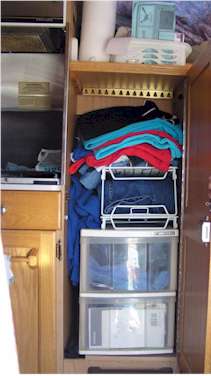 |

The drawer over the cab is another available option from Roadtrek. It provides a surprising amount of storage. It is a good place to carry the ridiculous amount of documentation needed to live anywhere but particularly needed to live in an RV on the road; things like appliance manuals and warranties, vehicle titles and maintenance records, bills and receipts, insurance policies, etc. We also carry our complete medical records Here.
Notice the pad mounted in the center. With it, bumping your head is only an annoyance instead of a mind numbing experience. Also note that the back of the driver's seat makes a good hat rack.
| This is the cabinet under the stove. Plastic boxes help to sort out the items stored here and to secure them while traveling. the boxes slide out like a drawer to make it easy to find and retrieve items stored there. The only really noteworthy feature of this cabinet is the appliance stored on the bottom shelf. It is a combination toaster oven and bread maker. In use it sits on the counter under the microwave. It is a small annoyance to set it up and put it away but the advantage of the occasional batch of cookies or fresh bread far outweigh that annoyance. |
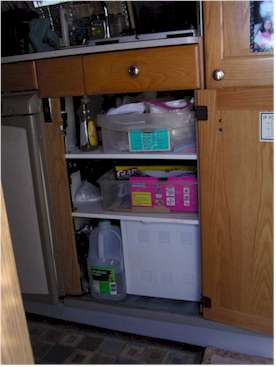 |
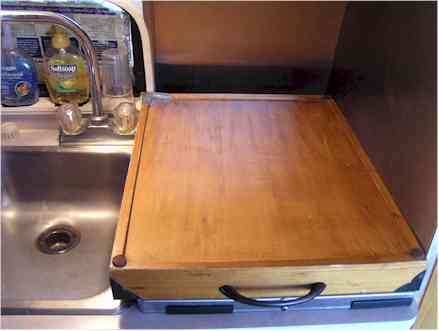
This van did not come with a cover for the stove. A wooden tray we found was an almost perfect fit. A small notch needed to be cut in one corner to clear the rim around the window. It even fits tightly enough that it need not be secured while traveling. More importantly it also serves other purposes. Stood on its side on the floor, it deflects to air from the furnace to the back of the van. It also serves as a tray to help move things such as dinner to a table outside.
The grey color you can see on the corner next to the window is the RVer's most important tool, duct tape. One RVer told me that he would rather leave his wife behind than his roll of duct tape. I agreed with him completely. I would rather leave his wife behind too.
| The window behind the sink provides a handy place to store hand
soap, sanitizer, and the electric toothbrush. Velcro on the bottom
and closing the window curtain hold them quite securely when traveling. On the left you can see the end of a toaster. It sits on a piece of the non-slip shelf liner. It remains securely in place even while driving. We met some people, also in a Roadtrek, about a year ago who had a coffee maker riding the same way on the counter with no ill effects. |
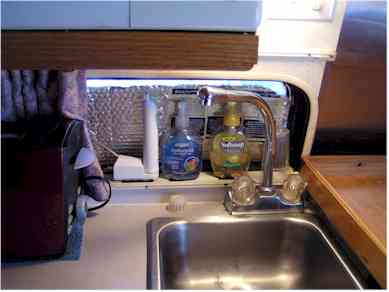 |
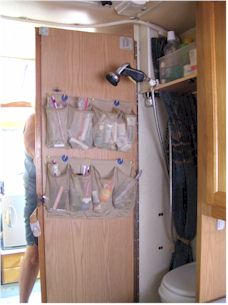
Inside the door we have mounted cloth shoe bags to hold things that would normally be in a medicine cabinet. The bags come in a large set that can be cut down to fit. This adds some additional weight to the door and it popped open once or twice while traveling. So we also added a strap latch to the door. We used a child safety latch we found in the baby department at Wal-Mart. The shelf above has a plastic box to organize and secure similar items.
As you can see, the shower head is somewhat un-standard. The original was awkward to use and did not completely shut off at the shower head. I tried other heads but they had the same problems. So I now use a garden hose sprayer. It turns off completely when you let go of it or you can lock it on continuously as you choose. This head also has a number of adjustments for the type of spray pattern. It does require a reducer to connect to the shower hose. This is a standard part found in any hardware store. We also replaced the heavy shower curtain with a lighter one. We shower at night and by morning the light curtain is completely dry and can safely be put away.
| The original rug was light blue and difficult to keep clean since we
do not carry a vacuum cleaner. We replaced it with inexpensive
throw rugs. They are easily picked up when you want to shower and
can be shook out rather than vacuumed. They also add a bit of
color. The two-drawer stand next to the driver's seat was originally in the back between the beds. In the back the drawers couldn't be opened when the table was in place. So we moved it to the front between the seats. In the front the cabinet turned out to be a convenient place to store maps, camping books and other things we need while driving. One drawer is devoted to the snacks I am addicted to. The appliance on top of the cabinet is a 12-volt cooler. The refrigerator in the Roadtrek is very small. I drink a lot of Coke (Coca Cola, that is) and there is not enough room in the refrigerator to keep it. It is also good for keeping lettuce and onions which too often freeze in the refrigerator. When we are traveling, the cooler rides on the floor in front of the furnace outlet. It can be reached from the passenger seat. This is convenient since it is the passenger's duty to keep the driver supplied with cold drinks and snacks. I do most of the driving. |
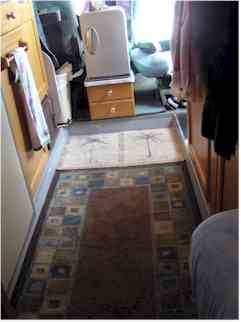 |
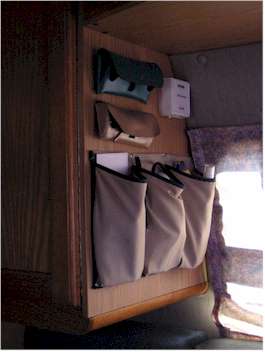
On the back side of the rear cabinet, shoe bags again provide storage. This time they hold things like remote controls, my computer mouse (this is my "side" of the table), etc.
There is no place in the van to lay down a pair of glasses. The two cases attached above the shoe bags take care of this problem. The second case is for the reading glasses I use when working on the computer.
| There is the same arrangement on the back of the TV cabinet.
The device hanging from the cup hook in the upper right part of the
picture is a remote control for the radio in the dashboard of the van.
I replaced the original radio with one that would play MP3 music files.
One MP3 disc will hold more than 280 songs. I can carry all my
music (about 1500 songs ) on 5 CDs. On the same kind of CDs, I also have hundreds of the old radio dramas from the 1930s and 1940s. These are shows like The Shadow, Amos and Andy, and Duffy's Tavern. One disc will hold about 100 half-hour shows in MP3 format. |
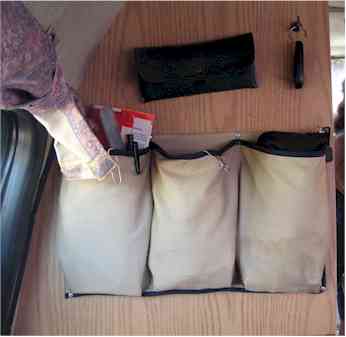 |
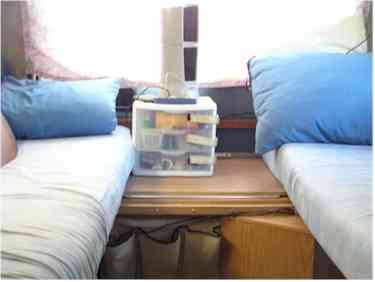
The covers seen on the beds are each made from a single, flat sheet cut to size with elastic added to make it into a fitted sheet. During the day they serve as slip covers to protect the cushions. At night, they become the bottom sheet when we make the bed.
We carry two notebook computers. We started out with one but quickly learned that while we share everything else very well, we do not amicably share one computer. To save the hassle of connecting power converters each time we use the computers, I mounted the converters beneath the bed near the Master relay. The output cables are coiled up in the shoe bags you can see in the bottom center of the picture.
The small white cabinet is the replacement for the large one that originally rode in the back. It provides storage for a variety of small items like duct tape, flash lights and batteries. The Velcro straps are to secure the drawers while traveling.
| The most important change to the outside of the van is the addition
of the Data Storm Satellite Internet System. This gives us
high-speed internet access almost any where we go. I know it works
as far south as Puerto Vallarta, Mexico since we were there last winter.
I was told that it still works in Acapulco. Maybe I'll find out
this winter. It often makes us very popular since we allow our
neighbors to use it as well. The antenna weighs 104 pounds and is mounted on a 2X4 foot aluminum plate to provide a secure base and to spread the weight on the rooftop. It lays down flat for traveling and doesn't seem to degrade performance. It adds only nine inches to our height when stowed. When it was being installed in an RV park in Texas, a neighbor came over to express his concern that it might tip the van over. He became much more supportive as he became convinced that all was well. He even pointed out that, with a trailing wind, it could be used as a sail to save fuel. |
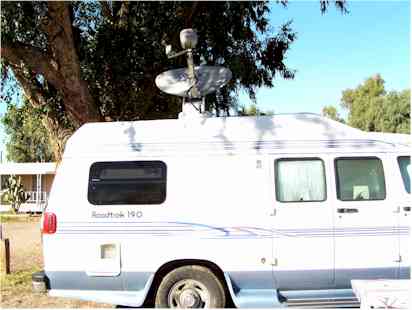 |

While we were planning our trip to Alaska, we heard all sorts of horror stories about the terrible roads and about damage done by rocks kicked up by passing trucks. We decided to install a guard to protect the radiator and headlights. This one was built and installed at an auto specialty shop in Nevada. It may be somewhat over designed. It is made from three inch steel pipe and is fully welded. It is secured to the frame by 28 three-eights inch bolts. We no longer need it for its original purpose but perhaps it will now serve as a deer guard.
| The latch on the hot water heater access door is difficult and expensive to replace. After replacing it twice in the first six months, I repaired it the next time using a tab from a beer can and some baling wire. It works fine and has lasted more than a year. |
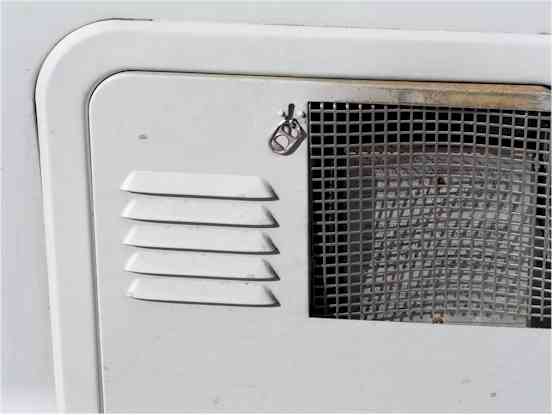 |
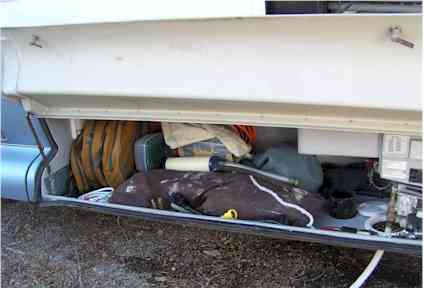
The round, brown bags in the left end of the outside compartment hold my two water hoses and the power extension cord. They take up less room since they can be stored on edge and are neat and untangled when I want to use them. The bags were advertised in a catalog from Nothern Tool and Equipment to hold jumper cables and, in fact, I use a fourth one for that purpose. The jumper cables are stored under the cover for the spare tire. The bags can be found online at
It is not obvious but there is a quick-disconnect on the water hose. Connecting the hose without this is an invitation to skinned knuckles and language that may not endear you to your neighbor.
| And last but not least is the sign on the back of our home. We
show our name and email address because we want people to communicate
with us. So far it hasn't resulted in any spam. The common
factor between us and the turtles has nothing to do with speed, although
we are generally not in any hurry to get any place, but has to do with
the fact that a turtle carries his home around with him and so do we. The four strange looking characters between the two turtles is the Cherokee word for "turtle". It is written using the Cherokee alphabet invented by a Cherokee named Sequoia in the early 1800s and is still used today. Sequoia did not speak English nor could he read or write in any language. He used the characters from an old English book having no idea what they meant. It looks strange to us but it works very well. By 1860, there were a number of books and newspapers being published in the Cherokee Nation, more than in any state in the union. There was also, by the way, a 95% literacy rate there compared to about 30% in any state. In case you haven't already guessed, I am a half-breed Cherokee out of Oklahoma and rather proud of it . |
 |
None of the changes or additions we have made are very significant but together they have made living and traveling in this small rig not only possible but the greatest of pleasures.